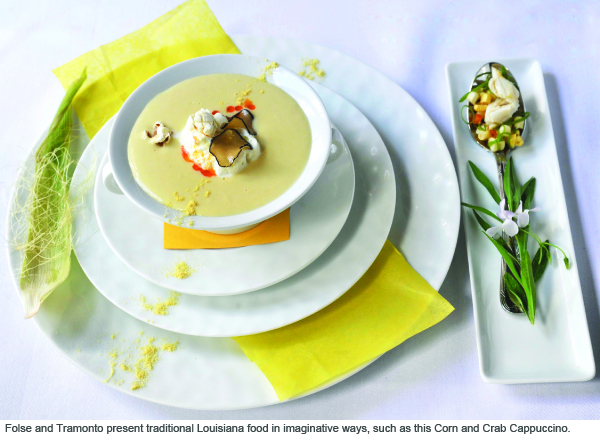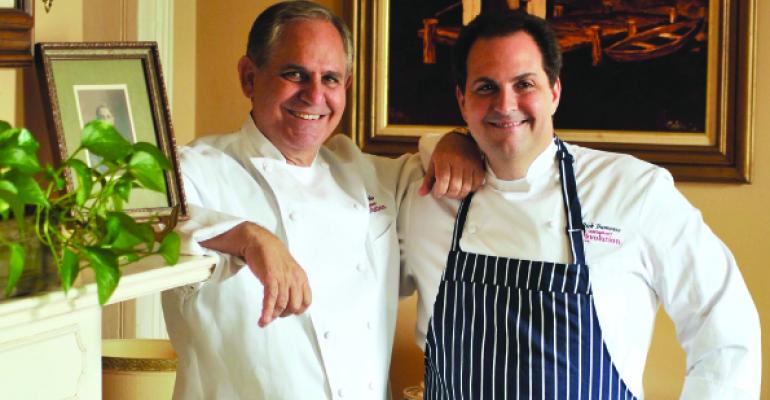John Folse and Rick Tramonto must have been tempted to phone it in at Restaurant R’evolution, their new joint venture in New Orleans. Both these noted chefs could have attracted plenty of customers by name recognition alone, each could have drawn from a career-long list of signature items to populate the menu and the restaurant’s location—the Royal Sonesta Hotel, which sits at the very epicenter of the French Quarter—guaranteed a level of foot traffic matched only by New York City’s Times Square. This was a can’t-miss restaurant if ever there was one; why would Folse and Tramonto kill themselves?
But kill themselves they did. Folse, 65, and Tramonto, 50, spent almost two years bringing Restaurant R’evolution to life. The 6,000-sq,-ft. project, which cost $6.5 million and seats 200, opened in June. Its calling card: polished renditions of classic South Louisiana cuisine.
Each partner in their newly formed company (Home on the Range: Folse Tramonto Restaurant Development, LLC) lends unique skills to Restaurant R’evolution.
Folse is a walking encyclopedia of South Louisiana cuisine, and the six food companies he currently runs are housed in a 48,000-sq.-ft. facility in Donaldsonville, LA. He has a national reputation as the keeper of Louisiana culinary traditions, but has never had a restaurant in New Orleans.
Neither has Tramonto, whose career has taken him from his hometown of Rochester, NY to some of the great kitchens of Europe to a series of standout restaurants of his own in his adopted hometown of Chicago. The most notable was Tru, where he was honored with a Best Chef/Midwest designation from the James Beard Awards. He moved to New Orleans to work on this project with Folse.
So what happens when two chefs who have run their own shows for decades collaborate to produce tradition-bound food in a contemporary restaurant setting? Early reviewers are ecstatic that the duo actually came up with something that was worth the wait and played to each chef’s strengths.
South Louisiana is unique from a culinary perspective in that it has a robust indigenous cuisine. While chefs elsewhere in the U.S. have recently taken a strong interest in serving local and seasonal fare, doing so has been a way of life in this part of the country for centuries. Folse’s vast experience preparing these dishes helped Restaurant R’evolution get the flavors and textures of its classics-laden menu just right.
Reinventing the classics
Perhaps the lone drawback to Creole and Cajun food has been that those who prepare it in restaurants often stick to serving faithful reproductions of generations-old recipes. So even though great New Orleans chefs like Emeril Lagasse, John Besh and Donald Link set a high standard for the Cajun/Creole repertoire, Folse thought a contemporary reinterpretation of it was overdue.
That’s were Tramonto came in. His job was to reinvent the classics and give them the kind of knockout presentations he was famous for at Tru.
Folse and Tramonto are much more than figureheads at their new restaurant. But day-to-day production is in the capable hands of chef de cuisine Chris Lusk, last seen at New Orleans standout Café Adelaide.
This crew’s ambitious 97-item menu starts off with four soups (Creole Louisiana Snapping Turtle Soup, deviled quail eggs, Madeira, $10; Death by Gumbo, roasted quail, andouille, oysters, filé rice, $12) and five salads. There are six hot (Beer-battered Crab Beignets, $12; Crabmeat-stuffed Louisiana Frog Legs Nicoise, fennel, saffron, $18) and cold (Espresso-crusted Venison Carpaccio, black walnuts, shaved dark chocolate, $14; Oysters on the Half Shell, R’evolution-style, cucumber lemon granita, tangerine salsa, $20 for a dozen) appetizers.
A half-dozen charcuterie boards, six potted meats and terrines and five versions of Tramonto’s signature caviar staircase round out the starter options. The five pasta options include Fazoletti with Crawfish (handkerchief pasta, sweet corn, fried sage, orange zest, $21); and Oysterman’s Spaghettini (Creole tomatoes, cream, shaved bottarga, $19).
At the entrée level, there are six fish choices (Gulf Shrimp and Grits “Village de l’Est,” stir-fried with chiles, ginger, stone ground cheese grits, $36; Red Snapper and Pork Belly a la Plancha, white root vegetable puree, cabbage, creole mustard, $29) and nine items on the meat and game list (Triptych of Quail: Southern-fried, Boudin-stuffed, Absinthe-glazed, $32). A half-dozen each vegetables and starch dishes in the $5-9 range comprise the side dish choices. Steak and chop lovers choose from among 10 options that can be dressed up with one of eight sauces and an additional eight toppers, all of which cost extra.
Atlanta-based The Johnson Studio designed Restaurant R’evolution’s interiors. There are seven unique dining rooms, each separated by New Orleans-style pocket doors and featuring lavish details worthy of the food and the Royal Sonesta setting.
So what’s “revolutionary” about this restaurant beside the odd-couple pairing of two prestigious chefs? This might be the place that returns Cajun and Creole food to the forefront of U.S. cooking.
It’s been on the back burner since Paul Prudhomme first popularized these dishes nationally in the 1980s. People loved the flavors, but the look and consistency of many items often had more in common with homestyle-like comfort food than serious restaurant fare.
Folse and Tramonto are changing that at Restaurant R’evolution. Their dishes have a look worthy of the complexity of their flavors. Expect foodies to go crazy over this place.





